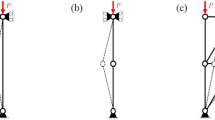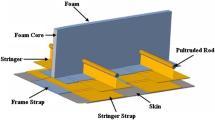Abstract
Improving the crashworthiness performance of the expansion tube of the coupler system using the limited deformation space at the vehicle end is of vital significance for the collision safety of trains. Nevertheless, an optimal design could become less meaningful or even unacceptable when some uncertainties are present. To address the issue, this paper firstly proposes a two-stage variable thickness expansion tube for the coupler system and investigates its crashworthiness performance through the impact test and finite element (FE) simulation. Associated with the verified FE model, parametric studies are performed to evaluate the effects of design variables on specific energy absorption (SEA), maximum crushing force (Fmax) and crushing force efficiency (CFE). The results show that variation in thickness (\(t_{1}\), \(t_{2}\)) of different stages for the expansion tube has a significant effect on CFE, but they have no obvious effects on the SEA. Meanwhile, \(r_{in}\) and α have a significant effect on SEA, while they have a smaller effect on CFE. Furthermore, a multiobjective robust optimization process is developed to address the effects of parametric uncertainties of the expansion tube on design optimization, which comprises a sampling approach, surrogate model, six-sigma-based robust design, the non-dominated sorting genetic algorithm II, Monte Carlo verification and technique for order preference by similarity to ideal solution. It is found that the reliability of constraints (Fmax, Fm) of multiobjective robust optimization is increased from 87.0 to 94.4% in the case of two objectives (max [CFE, SEA]) and from 90.0 to 93.3% in the case of three objectives (max [CFE, SEA,− Fmax]) compared to those in the deterministic optimization, respectively. Meanwhile, CFE and SEA values in the cases of two objectives (max [CFE, SEA]) and three objectives (max [CFE, SEA,− Fmax]) are improved by 17.95%, 5.30% and 16.57%, 15.62% compared to the original structure, respectively. Thus, it was demonstrated that the proposed procedure is effective and can be used to multiobjective robust optimization problems in practical engineering applications.















Similar content being viewed by others
References
Baril C, Yacout S, Clément B (2011) Design for Six Sigma through collaborative multiobjective optimization. Comput Ind Eng 60(1):43–55
Choi WM, Kim JS, Jung HS, Kwon TS (2011) Effect of punch angle on energy absorbing characteristics of tube-type crash elements. Int J Automot Technol 12(3):383–389
Du X, Venigella PK, Liu D (2009) Robust mechanism synthesis with random and interval variables. Mech Mach Theory 44(7):1321–1337
Fang J, Sun G, Qiu N, Kim NH, Li Q (2017) On design optimization for structural crashworthiness and its state of the art. Struct Multidisc Optim 55(3):1091–1119
Gao G, Dong H, Tian H (2014) Collision performance of square tubes with diaphragms. Thin-Walled Struct 80:167–177
Gao Q, Wang L, Wang Y (2016) Crushing analysis and multiobjective crashworthiness optimization of foam-filled ellipse tubes under oblique impact loading. Thin-Walled Struct 100:105–112
Gao G, Guan W, Li J, Dong H, Zou X, Chen W (2017) Experimental investigation of an active–passive integration energy absorber for railway vehicles. Thin-Walled Struct 117:89–97
Gao Q, Zhao X, Wang C, Zhang H (2018) Multi-objective crashworthiness optimization for an auxetic cylindrical structure under axial impact loading. Mater Design 143:120–130
Gao G, Zhuo T, Guan W (2020) Recent research development of energy-absorption structure and application for railway vehicles. J Cent South Univ 27(4):1012–1038
Gu X, Sun G, Li G, Mao L (2013) A comparative study on multiobjective reliable and robust optimization for crashworthiness design of vehicle structure. Struct Multidisc Optim 48(3):669–684
Guan W, Gao G, Yu Y, Zhuo T (2020) Crashworthiness analysis and multi-objective optimization of expanding circular tube energy absorbers with cylindrical anti-clamber under eccentric loading for subway vehicles. Struct Multidisc Optim 1–19
Guan W, Gao G, Yu Y (2021) Crushing analysis and multiobjective crashworthiness optimization of combined shrinking circular tubes under impact loading. Struct Multidisc Optim 1–19
Guangjun G (2019) The energy distribution of a train impact process based on the active–passive energy-absorption method. Trans Saf Environ 1(1):54–67
Hallquist JO (2007) LS-DYNA keyword user’s manual. Livermore Softw Technol Corpor 970:299–800
Ince ST, Kumar A, Park DK, Paik J (2017) An advanced technology for structural crashworthiness analysis of a ship colliding with an ice-ridge: numerical modelling and experiments. Int J Impact Eng 110:112–122
Jiang L, Shi YL, Cui YL (2002) Effect of low strain rate on strength of Q 235 and 20 MnSi steel. Heat Treatm Metals 7:9–12
Koch PN, Yang RJ, Gu L (2004) Design for six sigma through robust optimization. Struct Multidisc Optim 26(3):235–248
Kwang HA, ** SK, Hoon H (2008) Energy absorption of expansion tube considering local buckling characteristics. Int J Mod Phys B 22(31–32):5993–5999
Lei F, Lv X, Fang J, Li Q, Sun G (2021) Nondeterministic multi-objective and multi-case discrete optimization of functionally-graded front-bumper structures for pedestrian protection. Thin-Walled Struct 167:106921
Li F, Sun G, Huang X, Rong JH (2015) Multiobjective robust optimization for crashworthiness design of foam filled thin-walled structures with random and interval uncertainties. Eng Struct 88:111–124
Liu Y, Qiu XM (2016) A theoretical study of the expansion metal tubes. Int J Mech Sci 114:157–165
Liu B, Villavicencio R, Soares CG (2013) Experimental and numerical plastic response and failure of pre-notched transversely impacted beams. Int J Mech Sci 77:314–332
Lönn D, Bergman G, Nilsson L, Simonsson K (2011) Experimental and finite element robustness studies of a bumper system subjected to an offset impact loading. Int J Crashworthiness 16(2):155–168
Lu G (2002) Energy absorption requirement for crashworthy vehicles. Proceed Instit Mech Eng 216(1):31–39
Lu G, Yu TX (2003) Energy absorption of structures and materials. Elsevier
Messac A, Mattson CA (2002) Generating well-distributed sets of Pareto points for engineering design using physical programming. Optim Eng 3(4):431–450
Moreno C (2015) Identification, test and performance prediction of a novel energy absorbing mechanism for railway vehicles. University of Warwick
Morquio A, Riera JD (2004) Size and strain rate effects in steel structures. Eng Struct 26(5):669–679
Railway Group Standard GM/RT 2100, Structural Requirements for Railway Vehicles. (2000)
Suchao X, Haihong L, Yang Weilin WN (2018a) Crashworthiness optimisation of a composite energy-absorbing structure for railway vehicles. Struct Multidisc Optim 57(4):1793–1807
Suchao X, Haihong Li, Chengxing Y (2018b) Crashworthiness optimization of a composite energy-absorbing structure for subway vehicles based on hybrid particle swarm optimization. Struct Multidisc Optim 58(5):2291–2308
Sun G, Li G, Zhou S, Li H (2011) Crashworthiness design of vehicle by using multiobjective robust optimization. Struct Multidisc Optim 44(1):99–110
Sun G, Song X, Baek S, Li Q (2014) Robust optimization of foam-filled thin-walled structure based on sequential Kriging metamodel. Struct Multidisc Optim 49(6):897–913
Sun G, Li S, Liu Q, Li G, Li Q (2016) Experimental study on crashworthiness of empty/aluminum foam/honeycomb-filled CFRP tubes. Compos Struct 152:969–993
Tan B, Yao S, Zhang L, Ban H (2021) Thermo-mechanical coupling analysis of expansion tubes: Theoretical prediction and experimental investigation. Thin-Walled Struct 162:107559
Tang H, Shi Y, Dong P (2019) Public blockchain evaluation using entropy and TOPSIS. Expert Syst Appl 117:204–210
Wang S, Peng YWT (2019) Collision performance and multi-objective robust optimization of a combined multi-cell thin-walled structure for high speed train. Thin-Walled Struct 135:341–355
Wang S, Peng Y, Wang T, Chen X, Hou L, Zhang H (2019) The origami inspired optimization design to improve the crashworthiness of a multi-cell thin-walled structure for high speed train. Int J Mech Sci 159:345–358
Wei L, Zhang L, Tong X, Cui K (2021) Crashworthiness study of a subway vehicle collision accident based on finite-element methods. Int J Crashworthiness 26(2):159–170
**e S, Li H, Yang C, Yao S (2018) Crashworthiness optimisation of a composite energy-absorbing structure for subway vehicles based on hybrid particle swarm optimisation. Struct Multidisc Optim 58(5):2291–2308
Xu P, Yang CPY (2016a) Crash performance and multi-objective optimization of a gradual energy-absorbing structure for subway vehicles. Int J Mech Sci 107:1–12
Xu P, Yang CPY (2016b) Cut-out grooves optimization to improve crashworthiness of a gradual energy-absorbing structure for subway vehicles. Mater Des 103:132–143
Yan J, Yao S, Xu P, Peng Y, Shao H, Zhao S (2016) Theoretical prediction and numerical studies of expanding circular tubes as energy absorbers. Int J Mech Sci 105:206–214
Yang J, Luo M, Hua Y, Lu G (2010) Energy absorption of expansion tubes using a conical–cylindrical die: experiments and numerical simulation. Int J Mech Sci 52(5):716–725
Yao W, Chen X, Luo W, Tooren M, Guo J (2011) Review of uncertainty-based multidisciplinary design optimization methods for aerospace vehicles. Prog Aerosp Sci 47(6):450–479
Yao S, Li Z, Yan J, Xu P (2018a) Analysis and parameters optimization of an expanding energy-absorbing structure for a rail vehicle coupler. Thin-Walled Struct 125:129–139
Yao S, **ao X, Xu P, Qu Q, Che Q (2018b) The impact performance of honeycomb-filled structures under eccentric loading for subway vehicles. Thin-Walled Struct 123:360–370
Zhu P, Zhang Y, Chen GL (2009) Metamodel-based lightweight design of an automotive front-body structure using robust optimization. Proceed Instit Mech Eng 223(9):1133–1147
Zhu T, **ao S, Lei C, Wang X, Zhang J, Yang B, Yang G, Li Y (2021) Rail vehicle crashworthiness based on collision energy management: an overview. Int J Rail Trans 9(2):101–131
Funding
The authors gratefully acknowledge the financial support from the National Natural Science Foundation of China (51975588).
Author information
Authors and Affiliations
Corresponding author
Ethics declarations
Conflict of interest
The authors declare that they have no conflict of interest.
Replication of results
The data used to support the findings of this study are available from the corresponding author upon request, although all necessary details are included in the paper.
Additional information
Responsible Editor: Erdem Acar
Publisher's Note
Springer Nature remains neutral with regard to jurisdictional claims in published maps and institutional affiliations.
Rights and permissions
About this article
Cite this article
**, X., Lu, J. & Guan, W. Crashworthiness analysis and multiobjective robust optimization of two-stage variable thickness expansion tube under impact loading. Struct Multidisc Optim 65, 178 (2022). https://doi.org/10.1007/s00158-022-03267-0
Received:
Revised:
Accepted:
Published:
DOI: https://doi.org/10.1007/s00158-022-03267-0




